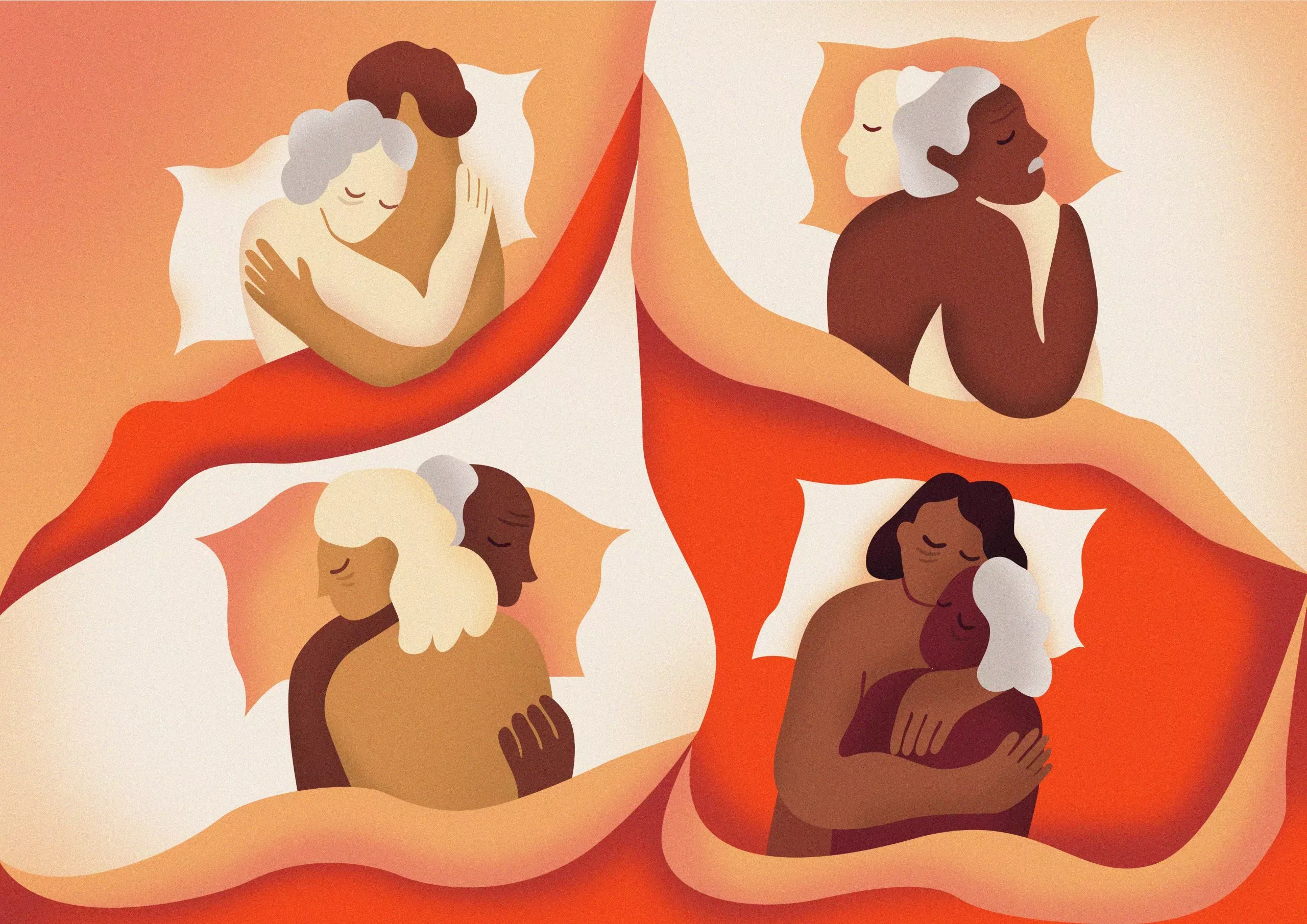Your cart is currently empty!

Menopause, Transition, and Fluidity: Conversations with People Aged 60 and Over About Sex
Seniors were born in an entirely different world, a world where sexuality was not yet part of popular conversation. They have seen their bodies, ideas, sexualities, and society age and change over time. Chloé, Bruce, and Diane, three people aged 60 and over, share bits and pieces of their sex lives with us.
“People aged 60 and over also have the right to a fulfilling sex life. Sexuality is a facet of life that deserves to be lived, regardless of age,” says Diane, who is making the most of her new life as a retiree.
Menopause, vaginal dryness, and a fulfilling sex life
Diane, 62, separated from the father of her three children twenty years ago. At the time, she thought she had problems with desire, but now she realizes that there was no problem. “We can say what we want, but when you work full time and have children on top of it all, it’s hard to find the time to make love with your partner. At night, I just wanted to go to bed.
»
The sexagenarian is now taking advantage of the lull of retirement by taking the time to live and experience moments of tenderness with her spouse of the past four years. The couple makes love once or twice a week, more often when Diane’s partner, who is still working, is on holiday. She also feels more comfortable doing things with him that she didn’t dare do when she was younger, like touching herself to orgasm during sex.
“The perk of being retired is feeling less tired and stressed out. When I had big, important tasks to do, I always had something on my mind that tormented me and kept me from letting go,” she explains.
Diane explains that getting older has enabled her to better understand her body, her turn-ons, and her boundaries, among other things. She adds that, in her case, certain physical limitations have emerged with age. Read: she suffered from vaginal dryness for several years before a friend of hers, who went through the same thing, told her about bioidentical hormones.
Diane consulted her doctor and asked her for a prescription. She quickly noticed that her insomnia and hot flashes decreased. In addition to taking hormones, her pharmacist suggested that she use vaginal suppositories to help with lubrication, which she did.
“Making love while suffering from vaginal dryness is to experience pain with each penetration. I can’t believe we’ve never been told about these treatment options before.” Diane has since made it her mission to spread the good news to the women around her.
Taking gender dysphoria by the horns
Aged 73, Chloé has known she was a girl since the age of 9, despite what her body suggested at the time. It took her a lifetime—67 years to be exact—2 marriages, and a child to come out as a trans lesbian woman.
Afterward, things quickly moved along: hormone therapy, name change, modification of gender markers on official documents, and gender-affirming surgery (vaginoplasty).
For the past six years, she has been involved with the LGBTQIA+ community in various ways, especially through Fondation Émergence, which fights against homophobia and transphobia. She was also the first trans woman to sit on the board of directors of the Quebec Lesbian Network.
“I always knew I was a woman, but what I didn’t know was how I was going to deal with it in society at large,” she says.
Experiencing her first female orgasm at age 67
Chloé, who has had several romantic and sexual relationships over the last six years, explained that she has spent the last few years rediscovering her sexuality, a bit as though she were re-experiencing adolescence, a formative time during which the contours of our sexual and gender identities take shape. She also said that it took her time, as well as a physiotherapist’s help, to figure out how the female orgasm works.
“Not many people can claim to have experienced both male and female orgasms, but I can,” she says. “It took me a long time to have my first female orgasm, but when I understood how my new body worked… it was just: WOW! It was so good that it felt as though my head was going to explode.”
For six years, Chloé has enjoyed exploring her new sexuality, which, for her, is as important as food and water. However, she can’t help but worry about when she will have to leave her home to go live in a seniors’ residence, and fears a lack of openness in matters of sexuality and gender identity.
A whole life to share, away from others’ gazes
“Here, the word ‘sexuality’ is taboo. We don’t talk about it,” explains Bruce, who has lived in a seniors’ residence with his wife, Mimi, for the past nine years.
Bruce and Mimi have been together for 62 years. Neither completely straight nor completely bisexual, they explored their sexuality together with several people—both men and women—over the years. The couple met in 1960, when they were 17, and they have never left each other since. They married in 1965 and had two children over the next few years.
As in many relationships, everyday life and everything that comes with it has had a direct impact on Bruce and Mimi’s sex life. It was after seeing an ad in the Yellow Pages that the couple embarked on swinging.
The pair started with one Saturday night date. Then they had another. Before they knew it, they had spent 10 years of Saturday nights meeting couples who, like them, have wanted to spice up their sex lives through swinging. Thus ensued years of discovering naturist centres all over the world, pushing back against sexual labels, and enjoying freedom and fluidity.
“Swinging saved our marriage and enabled us to meet lots of beautiful people and explore our sexuality fully,” says Bruce, who sometimes dreams of doing it all over again.
Now in a seniors’ residence, the couple takes pleasure in reminiscing while continuing to nourish their sexuality, though now exclusively for two.
“My most vivid memory is of the first time a man came and rubbed up against me. I still remember it vividly years later,” says Bruce with a hint of nostalgia.
Today, Bruce has fun stimulating his prostate with a vibrating dildo. As for Mimi, she likes to masturbate to pornography using a vibrator.
-
Curcio, J. J., Wollner, D. A., Schmidt, J. W., & Kim, L. S. (2006). Is bio-identical hormone replacement therapy safer than traditional hormone replacement therapy? Treatments in Endocrinology, 5(6), 367–374. 10.2165/00024677-200605060-00005
Fishman, J. R., Flatt, M. A. et Settersten Jr, R. A. (2015). Bioidentical hormones, menopausal women, and the lure of the “natural” in US anti-aging medicine. Social Science & Medicine, 132, 79-87. 10.1016/j.socscimed.2015.02.027.
Garcia, M. M. (2018). Sexual function after shallow and full-depth vaginoplasty: Challenges, clinical findings, and treatment strategies—urologic perspectives. Clinics in Plastic Surgery, 45(3), 437-446. https://doi.org/10.1016/j.cps.2018.04.002
Grossman, A. H., Frank, J. A., Graziano, M. J., Narozniak, D. R., Mendelson, G., El Hassan, D. et Patouhas, E. S. (2014). Domestic harm and neglect among lesbian, gay, and bisexual older adults. Journal of Homosexuality, 61(12), 1649-1666. https://doi.org/10.1080/00918369.2014.951216
Harris, E. A., Gormezano, A. M. et van Anders, S. M. (2022). Gender inequities in household labor predict lower sexual desire in women partnered with men. Archives of Sexual Behavior, 51(8), 3847-3870. https://doi.org/10.1007/s10508-022-02397-2
Herbenick, D., Reece, M., Hensel, D., Sanders, S., Jozkowski, K. et Fortenberry, J. D. (2011). Association of lubricant use with women’s sexual pleasure, sexual satisfaction, and genital symptoms: a prospective daily diary study. The journal of sexual medicine, 8(1), 202-212. https://doi.org/10.1111/j.1743-6109.2010.02067.x
Herbenick, D., Reece, M., Sanders, S., Dodge, B., Ghassemi, A. et Fortenberry, J. D. (2009). Prevalence and characteristics of vibrator use by women in the United States: Results from a nationally representative study. The Journal of Sexual Medicine, 6(7), 1857-1866. https://doi.org/10.1111/j.1743-6109.2009.01318.x
James, S. E., Herman, J. L., Rankin, S., Keisling, M., Mottet, L. et Anafi, M. (2016). The Report of the 2015 U.S. Transgender Survey. Washington, DC: National Center for Transgender Equality. https://transequality.org/sites/default/files/docs/usts/USTS-Full-Report-Dec17.pdf
Jiang, X., Bossert, A., Parthasarathy, K. N., Leaman, K., Minassian, S. S., Schnatz, P. F. et Woodland, M. B. (2021). Safety assessment of compounded non-FDA-approved hormonal therapy versus FDA-approved hormonal therapy in treating postmenopausal women. Menopause, 28(8), 867-874. https://doi.org/10.1097/GME.0000000000001782
Johnson, M. D., Galambos, N. L. et Anderson, J. R. (2016). Skip the dishes? Not so fast! Sex and housework revisited. Journal of Family Psychology, 30(2), 203-213. https://doi.org/10.1037/fam0000161
Mahieu, L., Cavolo, A. et Gastmans, C. (2019). How do community-dwelling LGBT people perceive sexuality in residential aged care? A systematic literature review. Aging & Mental Health, 23(5), 529-540. https://doi.org/10.1080/13607863.2018.1428938
Murray, S. H., Milhausen, R. R., Graham, C. A. et Kuczynski, L. (2017). A qualitative exploration of factors that affect sexual desire among men aged 30 to 65 in long-term relationships. The Journal of Sex Research, 54(3), 319-330. https://doi.org/10.1080/00224499.2016.1168352
Panay, N. et le Medical Advisory Council of the British Menopause Society. (2019). BMS–consensus statement: Bioidentical HRT. Post Reproductive Health, 25(2), 61-63. https://doi.org/10.1177/2053369119841844
Reece, M., Herbenick, D., Sanders, S. A., Dodge, B., Ghassemi, A. et Fortenberry, J. D. (2009). Prevalence and characteristics of vibrator use by men in the United States. The Journal of Sexual Medicine, 6(7), 1867-1874. https://doi.org/10.1111/j.1743-6109.2009.01290.x
Reece, M., Rosenberger, J. G., Schick, V., Herbenick, D., Dodge, B. et Novak, D. S. (2010).
Characteristics of vibrator use by gay and bisexually identified men in the United States. The Journal of Sexual Medicine, 7(10), 3467-3476. https://doi.org/10.1111/j.1743-6109.2010.01873.xRosen, N. O., Mooney, K. et Muise, A. (2017). Dyadic empathy predicts sexual and relationship well-being in couples transitioning to parenthood. Journal of Sex & Marital Therapy, 43(6), 543-559. https://doi.org/10.1080/0092623X.2016.1208698
Schick, V., Herbenick, D., Rosenberger, J. G. et Reece, M. (2011). Prevalence and characteristics of vibrator use among women who have sex with women. The Journal of Sexual Medicine, 8(12), 3306-3315. https://doi.org/10.1111/j.1743-6109.2011.02503.x
Sims, K. E. et Meana, M. (2010). Why did passion wane? A qualitative study of married women’s attributions for declines in sexual desire. Journal of Sex & Marital Therapy, 36(4), 360-380. https://doi.org/10.1080/0092623X.2010.498727
Stanczyk, F. Z., Matharu, H. et Winer, S. A. (2021). Bioidentical hormones. Climacteric, 24(1), 38-45. https://doi.org/10.1080/13697137.2020.1862079
Whedon, J. M., KizhakkeVeettil, A., Rugo, N. A. et Kieffer, K. A. (2017). Bioidentical estrogen for menopausal depressive symptoms: A systematic review and meta-analysis. Journal of Women’s Health, 26(1), 18-28. https://doi.org/10.1089/jwh.2015.5628






